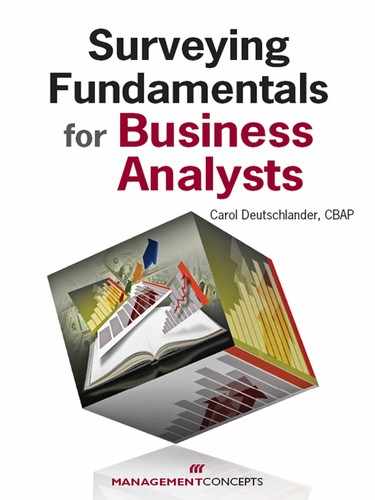Foreword
How many times have you wondered about the purpose behind a survey—or about its results and impact? How many surveys have you rushed through with no real regard or thought? Have you wondered how to select an appropriate survey audience? How confident are you that the surveys you create as a business analyst will produce valuable, objective results that contribute to your requirements processes?
If any of these questions are familiar, Surveying Fundamentals for Business Analysts is a must-read. Eliciting requirements is an important process needed to make informed business decisions. Only a very small portion of business analysts take the time to use surveys to elicit requirements, and a high percentage of those who do conduct surveys do so with only minimal structure and discipline. Surveying Fundamentals guides BAs toward the structure and discipline they need to improve the quality of requirements data.
Carol Deutschlander’s comprehensive discussion of the “scientific art” of surveys is impressive. She discusses the various types of surveys, an eight-step approach to the survey process, surveyor objectives, and survey question formats, including question appearance, length, order, and combinations.
Carol also describes how understanding the audience plays an important role in the development and delivery of surveys. She encourages readers to ask essential questions about the survey audience—who, what, where, and why—to uncover the kind of information needed to craft a survey producing maximum results:Who will benefit from the survey results? What decisions will be made with the output?Where will the financial support for this effort come from?Why might your audience want to participate in the survey?
Additional material worth highlighting includes a checklist at the end of Chapter 3 with best practices for writing successful questions and a Chapter 5 discussion of the importance of piloting surveys—a verification and validation practice often foregone by BAs who are short on time or resources. Chapter 7 helps readers interpret qualitative and quantitative data objectively, and Chapter 8 clarifies how to present survey results to stakeholders in a variety of formats, including lists, pie charts, bar charts, line charts, and tables. Checklists, templates, and case studies presented in the appendixes provide practical, hands-on best practices.
Readers who don’t dog-ear and highlight this important resource will struggle to gather relevant requirements they can trace to organizational goals and objectives. Carefully considering Carol’s insightful guidelines will enhance the surveys you create and lead you to more valuable, accurate requirements data.
Glenn R. Brûlé
Executive Director of Client Solutions
ESI International | an Informa business
Vice President of Chapters
International Institute of Business Analysis
